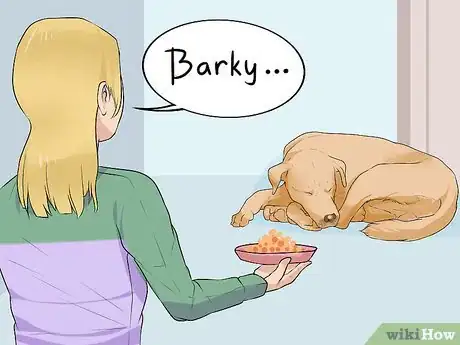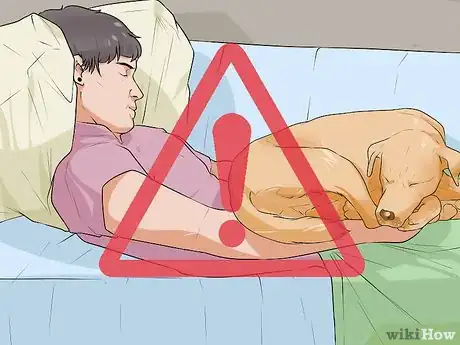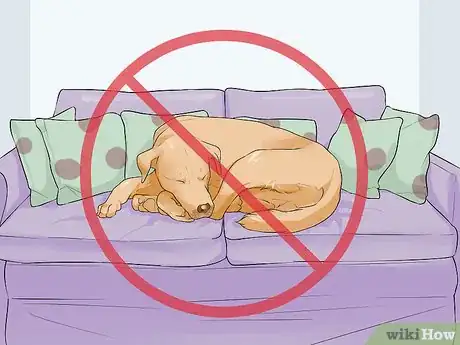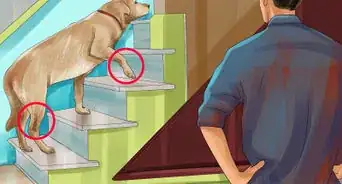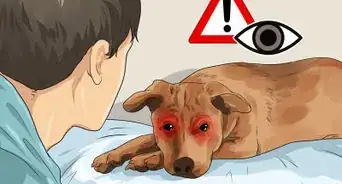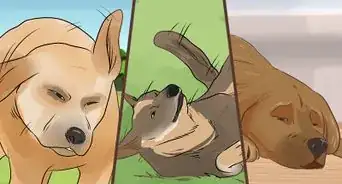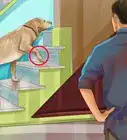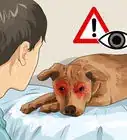This article was co-authored by Melissa Nelson, DVM, PhD. Dr. Nelson is a Veterinarian who specializes in Companion and Large Animal Medicine in Minnesota, where she has over 18 years of experience as a veterinarian in a rural clinic. She received her Doctor of Veterinary Medicine from the University of Minnesota in 1998.
This article has been viewed 24,230 times.
Older dogs can experience many behavioral changes. One change may be sleep aggression. Your dog may be sweet and loving at any other time, but when they are woken up, they suddenly get aggressive. Many dogs develop sleep aggression as they age. To handle this behavior change, you should take your dog to the vet, refrain from touching or waking them when they sleep, and give them a private place to sleep.
Steps
Dealing with Sleep Aggression in Your Dog
-
1Refrain from touching your dog during sleep. Dogs with sleep aggression are sensitive to touch or unexpected noises while they are sleeping. To reduce your dog’s stress and keep you from getting snapped at, try not to touch the dog while they’re sleeping.[1]
- Sometimes, the dog will allow their owners or certain members of their family to touch them during sleep but not others. Even if your dog doesn’t act aggressively when you touch them during sleep, avoid touching them in case their behavior changes.
-
2Take your dog to the vet. Behavioral changes are common in senior dogs. However, if you notice any behavioral changes in your senior dog, you should take them to the vet. Some behavioral changes are caused by underlying medical conditions that are treatable.
- Sleep aggression is more common in older dogs. Some breeds, such as greyhounds, are also more susceptible.
- Your vet may ask questions, such as "where does your dog sleep at night?" or "how much does your dog sleep?" They may recommend changing your dog's sleeping arrangements.
- If the vet determines it is a behavioral problem, they may refer you to a certified animal behaviorist for treatment.
Advertisement -
3Get tests done on your dog. If your vet believes that there is a medical cause to your dog's sleep aggression, they may do a physical examination, blood work, x-rays, urinary analyses, and other tests. Medication may be necessary if they find something wrong.[2]
- Treatment depends on what is causing the sleep aggression. Arthritis, hypothyroidism, Cushing's disease, and urinary tract infections can all be causes of sleep aggression.
- If your dog is diagnosed with cognitive dysfunction, they may be given a medication called selegiline hydrochloride (Anipryl). Follow your vet's instructions on dosage.
-
4Wait for a response before approaching your sleeping dog. When your dog is lying down, you should always call out to your dog before approaching them. Call your dog’s name softly to see if they respond. If they don’t, leave them alone.
- For example, if it is time to feed your dog, you can walk close to their bed and say their name. If they don’t open their eyes, sit up, or move, leave them sleeping.
Keeping Your Dog Undisturbed When Sleeping
-
1Confine the dog to one room. One way to help your senior dog if they have sleep aggression is to place the dog in a closed off room at night. You may put up a baby gate or close the door to keep the dog from roaming around the house at night. This also keeps your dog separate so they are not disturbed while sleeping.[3]
- You may want to place your dog in a room away from your bedroom so they won’t wake up if you get up during the night.
-
2Separate your dog from other pets when they sleep. Since sleep aggression can occur when the dog is woken suddenly, place your senior dog in another room when they sleep. This can reduce the chances that your other pets will disturb the dog and cause an aggressive outburst.[4]
- You may set up your dog’s bed in a place that is easily closed off when they go to it and settle down for a nap. You can just close the door or gate to separate them.
-
3Let your dog sleep in a crate. You may choose to give your older dog their own crate to sleep in. This will help them stay away from everything so they won’t get woken up. Crates also help give the dog a safe place that is their own where they can feel secure.
- When your dog sleeps in a crate, don’t close the door on the crate. Instead, place the crate in a private area they won’t be disturbed.
Protecting Your Family
-
1Refrain from waking your dog when they’re asleep. Even the most loving senior dogs may growl, snap, or bite when they are woken suddenly. If you know that your dog exhibits sleep aggression when they are woken up, you should make sure not to disturb them.[5]
- This may mean staying out of the room the dog is in or being quiet when you are around your sleeping dog.
-
2Keep children away while the dog is sleeping. Your children may not understand that the loving dog they play with will snap, growl, or bite at them when they wake it up. To help protect your dog and your child, keep the child away from the dog while they’re sleeping. This will reduce the likelihood of an accident.[6]
- Keep your children out of the room your dog is sleeping in or let them know they shouldn’t cross the gate.
- Explain to your kids that when the dog is sleeping, they are not to be disturbed.
-
3Avoid letting the dog sleep with the family. If your dog used to sleep with you or family members, sleep aggression may make it so the dog can’t do that anymore. They may get grumpy or act aggressively if you jostle them in their sleep or wake them up.[7]
- This includes letting your dog sleep with you on the couch when you’re sitting around watching television or reading a book. Instead, place your dog’s bed near you so they can sleep with you close, but not be disturbed by you moving around.
-
4Keep your dog off of the furniture. When your dog experiences sleep aggression, you shouldn’t allow your dog to get on the furniture. If your dog ends up on the couch, a bed, or in a chair, they could fall asleep. If a family member or visiting friend sits on the piece of furniture, the dog may act aggressively towards them.
- Place a soft bed or blankets on the floor so your dog will have a place to nap or rest that’s not on the furniture.
References
- ↑ https://www.aspca.org/pet-care/dog-care/common-dog-behavior-issues/behavior-problems-older-dogs
- ↑ http://pets.webmd.com/dogs/guide/behavior-problems-older-dogs#2
- ↑ http://www.peteducation.com/article.cfm?c=2+2110&aid=616
- ↑ https://www.aspca.org/pet-care/dog-care/common-dog-behavior-issues/behavior-problems-older-dogs
- ↑ https://www.aspca.org/pet-care/dog-care/common-dog-behavior-issues/behavior-problems-older-dogs
- ↑ https://www.aspca.org/pet-care/dog-care/common-dog-behavior-issues/behavior-problems-older-dogs
- ↑ https://www.aspca.org/pet-care/dog-care/common-dog-behavior-issues/behavior-problems-older-dogs
About This Article
To handle sleep aggression in a senior dog, confine it to a separate room, away from other humans and animals so it can’t harm anyone if it is disturbed. Another option is to give your dog a crate to sleep in, which will help it feel safe and secure as it sleeps. However, don’t close the crate door as your dog sleeps or it might feel trapped. Instead, place the crate in a private room. For more tips from our Veterinary co-author, like how to keep your family from getting bitten, read on!


